反射
什么是反射?
反射是指在程序运行期间,可以通过Reflection Api提供方法可以获取任何类的内部的信息,并能直接操作任意类的方法和属性。反射被视为动态语言的关键。
//在反射之前可以做的事情
@Test
public void Test1() {
//创建Person类的对象
Person person = new Person("name", 78);
//通过对象调用其内部的方法和属性
person.setAge(20);
System.out.println(person.toString());
person.show();
//在Person类的外部,不能通过对象调用其内部的私有的结构
}
//在反射之后可以做的事情
@Test
public void Test2() throws Exception {
//通过反射创建Person类的对象
Class classPerson = Person.class;
Constructor constructor = classPerson.getConstructor(String.class, int.class);
Object object = constructor.newInstance("Tom", 13);
Person person = (Person) object;
System.out.println(person.toString());
//通过反射获取Person内部的属性和方法
Field name = classPerson.getField("name");
name.set(person, "Jack");
System.out.println(person.toString());
//调方法
Method show = classPerson.getDeclaredMethod("show");
show.invoke(person);
//调用私有的构造方法
Constructor constructor1 = classPerson.getDeclaredConstructor(String.class);
constructor1.setAccessible(true);
Person person1 = (Person) constructor1.newInstance("Marry");
System.out.println(person1);
//调用私有的方法
Method showNation = classPerson.getDeclaredMethod("showNation", String.class);
showNation.setAccessible(true);
showNation.invoke(person1, "中国");
}
结果:
未使用反射
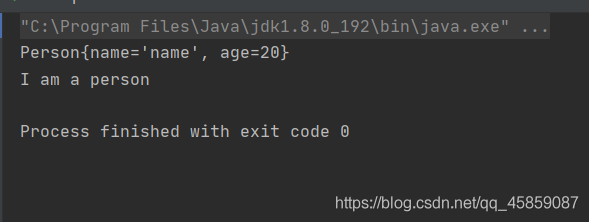
使用反射:
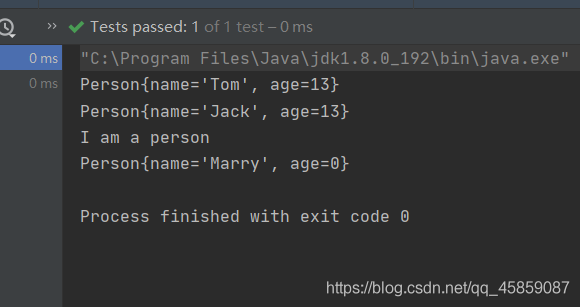
Person类
package reflection;
/**
* user:ypc;
* date:2021-06-20;
* time: 13:55;
*/
public class Person {
public String name;
private int age;
public String getName() {
return name;
}
public void setName(String name) {
this.name = name;
}
public Person() {
}
public int getAge() {
return age;
}
public void setAge(int age) {
this.age = age;
}
public Person(String name, int age) {
this.age = age;
this.name = name;
}
private Person(String name) {
this.name = name;
}
@Override
public String toString() {
return "Person{" +
"name='" + name + '\'' +
", age=" + age +
'}';
}
public void show() {
System.out.println("I am a person");
}
private String showNation(String nation) {
return nation;
}
}
反射的用途
1、在日常的第三方应用开发过程中,经常会遇到某个类的某个成员变量、方法或是属性是私有的或是只对系统应用开放,这时候就可以利用Java的反射机制通过反射来获取所需的私有成员或是方法 。
2、反射最重要的用途就是开发各种通用框架,比如在spring中,我们将所有的类Bean交给spring容器管理,无论是XML配置Bean还是注解配置,当我们从容器中获取Bean来依赖注入时,容器会读取配置,而配置中给的就是类的信息,spring根据这些信息,需要创建那些Bean,spring就动态的创建这些类。
Java程序中许多对象在运行时会出现两种类型:运行时类型(RTTI)和编译时类型,例如Person p = new Student();这句代码中p在编译时类型为Person,运行时类型为Student。程序需要在运行时发现对象和类的真实信息。而通过使用反射程序就能判断出该对象和类属于哪些类。
在类被加载完成之后,就会在堆区,产生一个Class对象,这个对象就包含了存这个类的全部的结构信息。我们就可以通过这个对象看到这个类的全部的信息。
这个对象就像一面镜子,通过这个镜子可以看到这个类的全部的信息结构。所以称之为反射。
正常的方式:通过引入需要导入的包类的名称---->通过new来实例化---->得到实例化的对象
反射的方式:实例化对象---->通过getClass()方法---->得到完整的包类的名称
反射的具体作用
- 在运行的时候判断任意的一个对象所属的类
- 在运行的时候构造任意一个类的对象
- 在运行 的时候判断任意一个类的成员变量和方法
- 在运行的时获取泛型的信息
- 在运行的时候调用任意一个类的成员变量和方法
- 在运行的时候处理注解
- 生成动态代理
反射的主要API
类名 用途
Class类 代表类的实体,在运行的Java应用程序中表示类和接口
Field类 代表类的成员变量/类的属性
Method类 代表类的方法
Constructor类 代表类的构造方法
通过直接new 的方式和反射 都可以直接调用公共的结构,在开发的时候应该使用哪一个呢?
建议:使用new 的方式来创建对象。
什么时候使用反射呢?
反射的特性:动态性。就是在编译的时候不知道要创建什么样的对象的时候,可以使用反射方式来创建对象。比如在后端部署的服务器,前端传来的时登录的请求的话,就创建登录对应的对象。前端传来的是注册所对应的请求的话,就创建登录所对应的对象,这就是反射的动态特性。
反射的机制和封装是不矛盾的呢?
封装是告诉你不要调,反射可以调。
Class类
在Object类中定义了以下的方法,此方法将被所有子类继承:
public final Class getClass()
以上的方法返回值的类型是一个Class类,此类是Java反射的源头,实际上所谓反射从程序的运行结果来看也很好理解,即可以通过对象反射求出类的名称。
对象使用反射后可以得到的信息:某个类的属性、方法和构造器、某个类到底实现了哪些接口。对于每个类而言,JRE都为其保留一个不变的Class类型的对象。一个Class对象包含了特定某个结构( class/interface/enum/annotation/primitive type/void/[])的有关信息。也就是这些类型可以有Class对象:class 成员内部类、 静态内部类、 局部内部类 、 匿名内部类、接口、数组、枚举、注解、基本的数据类型、void等。
注意:
Class本身也是一个类
Class对象只能由系统建立对象
一个加载的类在JVM中只会有一个Class实例
一个Class对象对应的是一个加载到JVM中的一个.class文件
每个类的实例都会记得自己是由哪个Class实例所生成
通过Class可以完整地得到一个类中的所有被加载的结构
Class类是Reflection的根源,针对任何你想动态加载、运行的类,只有先获得相应的Class对象,才能继续下去。
关于java.lang.Class的理解:
类的加载过程:
程序通过javac.exe命令,生成一个或多个字节码文件。接着使用java.exe命令来对某个字节码文件来解释运行。将字节码文件加载到内存中,这个过程称为类的加载。加载到内存中的类,就被称为运行时类,此运行使类就称为Class 的一个实例。
Class 实例就对应着一个运行时类,加载到内存中的运行时类,会缓存一段时间。在此时间之内,可以通过不同的方式来获取运行时类。
获取Class实例的四种方式
// Class 实例就对应着运行时类
@Test
public void test3() throws ClassNotFoundException {
//方式1 调用运行时类的属性:.class
Class clazz1 = Person.class;
System.out.println(clazz1);
//方式2 通过运行时类的对象来调用
Person person = new Person();
Class clazz2 = person.getClass();
System.out.println(clazz2);
//方式3 通过Class的静态方法 forName(类的全路径名称)
Class clazz3 = Class.forName("reflection.Person");
System.out.println(clazz3);
//方式4 通过类加载器:ClassLoader
ClassLoader classLoader = ReflectionDemo1.class.getClassLoader();
Class clazz4 = classLoader.loadClass("reflection.Person");
System.out.println(clazz4);
System.out.println(clazz1 == clazz2);
System.out.println(clazz1 == clazz3);
System.out.println(clazz1 == clazz4);
}
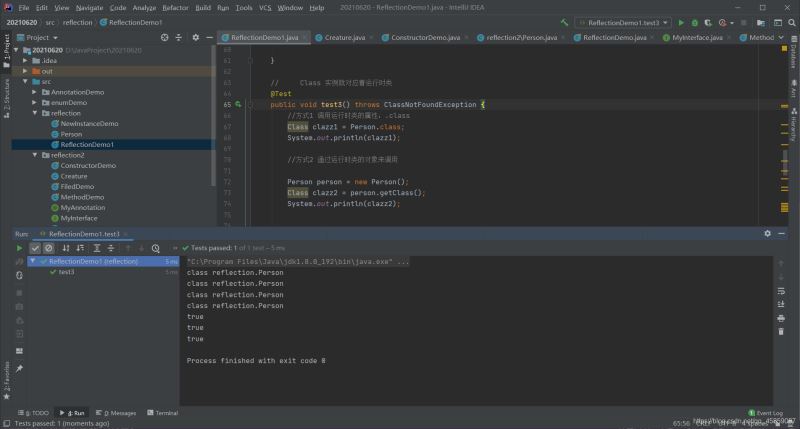
通过反射创建运行时类的对象
package reflection;
import org.junit.Test;
import java.util.Random;
/**
* user:ypc;
* date:2021-06-21;
* time: 20:36;
*/
public class NewInstanceDemo {
@Test
public void test1() throws IllegalAccessException, InstantiationException {
Class<Person> personClass = Person.class;
/*
newInstance()方法可以创建运行时类的实列,其内部也时调用内的无参的构造方法来创建对象
*/
Person person = personClass.newInstance();
System.out.println(person);
}
@Test
public void test2() throws IllegalAccessException, InstantiationException, ClassNotFoundException {
//在编译的时候不知道要创建的对象。只有运行的时候才知道要创建的对象
for (int i = 0; i < 100; i++) {
int num = new Random().nextInt(3);
String classPath = "";
switch (num) {
case 0:
classPath = "java.util.Date";
break;
case 1:
classPath = "java.lang.Object";
break;
case 2:
classPath = "reflection.Person";
break;
}
Object object = getInstance(classPath);
System.out.println(object);
}
}
//创建一个指定类的对象
public Object getInstance(String classPath) throws ClassNotFoundException, IllegalAccessException, InstantiationException {
Class clazz = Class.forName(classPath);
return clazz.newInstance();
}
}
通过反射获取运行类的属性及权限修饰符、变量名 、数据的类型
@Test
public void test1(){
//getFields()获取的是运行时类及其父类中public的属性
Class clazz = Person.class;
Field[] fields = clazz.getFields();
for (Field field: fields) {
System.out.println(field);
}
System.out.println();
//getDeclaredFields():获取当前运行类的所有属性
Field[] declaredFields = clazz.getDeclaredFields();
for (Field field:declaredFields) {
System.out.println(field);
}
}
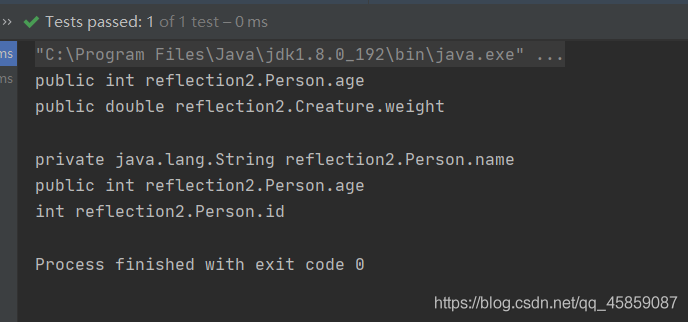
//权限修饰符 变量名 数据的类型
@Test
public void test2(){
Class clazz = Person.class;
Field[] declaredFields = clazz.getDeclaredFields();
for (Field field:declaredFields) {
//权限修饰符
System.out.println(Modifier.toString(field.getModifiers())+"\t");
//变量名
System.out.println(field.getType()+"\t");
//数据的类型
System.out.println(field.getName()+"\t");
}
}
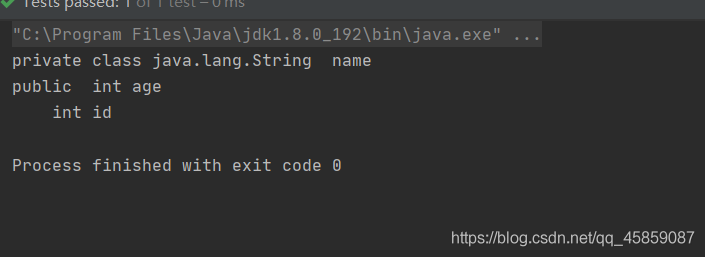
通过反射获取运行时类的方法结构及其内部结构
package reflection2;
import org.junit.Test;
import java.lang.annotation.Annotation;
import java.lang.reflect.Method;
import java.lang.reflect.Modifier;
/**
* user:ypc;
* date:2021-06-22;
* time: 13:32;
*/
public class MethodDemo {
@Test
public void test1() {
//获取当前运行时类及其父类中所有声明为public的方法
Class clazz = Person.class;
Method[] methods = clazz.getMethods();
for (Method method : methods) {
System.out.println(method);
}
System.out.println();
//获取当前运行时类所有的方法
Method[] declaredMethods = clazz.getDeclaredMethods();
for (Method method : declaredMethods) {
System.out.println(method);
}
}
//@xxx注解
//权限修饰符 方法结构 返回值的类型
@Test
public void test2() {
Class clazz = Person.class;
Method[] declaredMethods = clazz.getDeclaredMethods();
for (Method method : declaredMethods) {
//获取方法的注解
Annotation[] annotations = method.getDeclaredAnnotations();
for (Annotation annotation : annotations) {
System.out.print(annotation);
}
//获取权限的修饰符
System.out.print(Modifier.toString(method.getModifiers()) + "\t");
//获取返回值的类型
System.out.print(method.getReturnType().getName() + "\t");
//方法名
System.out.print(method.getName());
System.out.print("(");
//获取形参的列表
Class[] parameterTypes = method.getParameterTypes();
if (!(parameterTypes == null && parameterTypes.length == 0)) {
for (int i = 0; i < parameterTypes.length; i++) {
if (i == parameterTypes.length - 1) {
System.out.print(parameterTypes[i].getName() + " args__" + i);
} else {
System.out.print(parameterTypes[i].getName() + " args__" + i + ",");
}
}
}
System.out.print(")");
//获取方法的异常
Class[] exceptionTypes = method.getExceptionTypes();
if (exceptionTypes.length != 0) {
System.out.print("throws");
for (int i = 0; i < exceptionTypes.length; i++) {
if (i == exceptionTypes.length - 1) {
System.out.print(exceptionTypes[i].getName());
} else {
System.out.print(exceptionTypes[i].getName() + ",");
}
}
}
System.out.println();
}
}
}
test1():
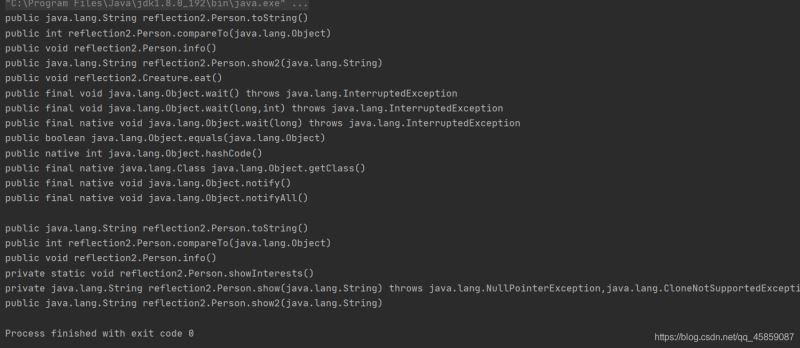
test2():

通过反射获取运行时类的构造结构
@Test
public void test1() {
Class clazz = Person.class;
//获取运行时类的public构造方法
Constructor[] constructors = clazz.getConstructors();
for (Constructor constructor : constructors) {
System.out.println(constructor);
}
System.out.println();
//获取当前运行时类中的所有的构造方法
Constructor[] declaredConstructors = clazz.getDeclaredConstructors();
for (Constructor declaredConstructor : declaredConstructors) {
System.out.println(declaredConstructor);
}
}
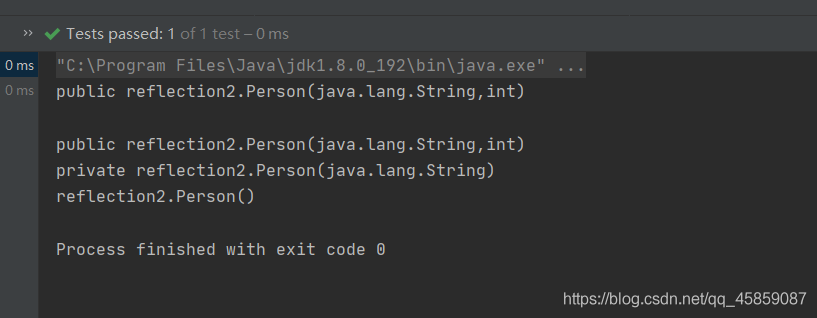
通过反射获取运行时类的父类和父类的泛型、注解、接口、所在包
反射所使用到的包、接口、类、注释等👇
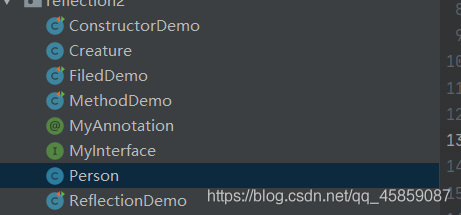
package reflection2;
/**
* user:ypc;
* date:2021-06-21;
* time: 21:38;
*/
public interface MyInterface {
void info();
}
package reflection2;
import java.lang.annotation.Retention;
import java.lang.annotation.RetentionPolicy;
import java.lang.annotation.Target;
import static java.lang.annotation.ElementType.*;
@Target({TYPE, FIELD,CONSTRUCTOR,ANNOTATION_TYPE,PARAMETER,LOCAL_VARIABLE,METHOD})
@Retention(RetentionPolicy.RUNTIME)
public @interface MyAnnotation {
String value() default "hello";
}
package reflection2;
import java.io.Serializable;
/**
* user:ypc;
* date:2021-06-21;
* time: 21:13;
*/
public class Creature<T> implements Serializable {
private char gender;
public double weight;
private void breath(){
System.out.println("creature breath");
}
public void eat(){
System.out.println("creature eat");
}
}
package reflection2;
@MyAnnotation(value = "hi")
public class Person extends Creature<String> implements Comparable, MyInterface {
private String name;
public int age;
int id;
Person() {
}
@MyAnnotation(value = "a")
private Person(String name) {
this.name = name;
}
public Person(String name, int age) {
this.name = name;
this.age = age;
}
private String show(String nation) throws NullPointerException,CloneNotSupportedException {
System.out.println("I am form" + nation);
return nation;
}
private static void showInterests(){
System.out.println("I like programmer");
}
@MyAnnotation(value = "b")
public String show2(String publicMethod) {
return publicMethod;
}
@Override
public int compareTo(Object o) {
return 0;
}
@Override
public void info() {
System.out.println("I am a Person");
}
@Override
public String toString() {
return "Person{" +
"name='" + name + '\'' +
", age=" + age +
", id=" + id +
'}';
}
}
package reflection2;
import org.junit.Test;
import java.lang.reflect.Constructor;
import java.lang.reflect.ParameterizedType;
import java.util.Arrays;
/**
* user:ypc;
* date:2021-06-22;
* time: 15:11;
*/
public class ConstructorDemo {
@Test
public void test1() {
Class clazz = Person.class;
//获取运行时类的public构造方法
Constructor[] constructors = clazz.getConstructors();
for (Constructor constructor : constructors) {
System.out.println(constructor);
}
System.out.println();
//获取当前运行时类中的所有的构造方法
Constructor[] declaredConstructors = clazz.getDeclaredConstructors();
for (Constructor declaredConstructor : declaredConstructors) {
System.out.println(declaredConstructor);
}
}
@Test
public void test2() {
//获取运行时类的父类
Class clazz = Person.class;
System.out.println(clazz.getSuperclass());
//获取运行时类带泛型的父类
System.out.println(clazz.getGenericSuperclass());
//获取父类所带的泛型
System.out.println(((ParameterizedType) clazz.getGenericSuperclass()).getActualTypeArguments()[0]);
System.out.println();
//获取运行时类的接口
Class[] interfaces = clazz.getInterfaces();
for (Class intF : interfaces) {
System.out.println(intF);
}
System.out.println();
//获取运行类的父类的接口
Class[] supInterfaces = clazz.getSuperclass().getInterfaces();
for (Class intF : supInterfaces) {
System.out.println(intF);
}
//获取运行时类的包
System.out.println(clazz.getPackage());
System.out.println();
//获取运行时类的注解
System.out.println(Arrays.toString(clazz.getAnnotations()));
;
}
}
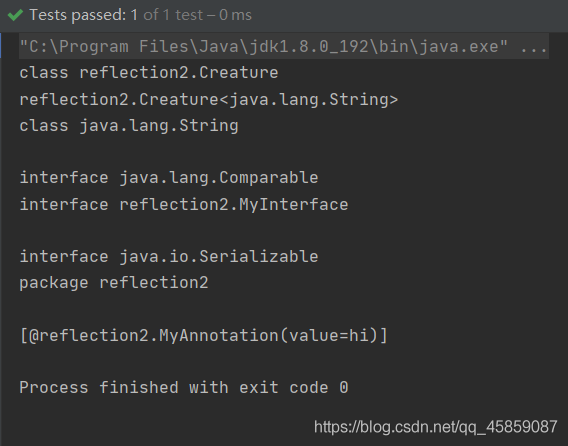
通过反射调用运行时类的指定属性、方法、构造方法
package reflection2;
import org.junit.Test;
import java.lang.reflect.Constructor;
import java.lang.reflect.Field;
import java.lang.reflect.Method;
/**
* user:ypc;
* date:2021-06-22;
* time: 15:57;
* 调用运行时类的指定的结构:方法、属性、构造方法
*/
public class ReflectionDemo {
@Test
public void test1() throws Exception {
Class clazz = Person.class;
//创建运行时类的实例
Person person = (Person) clazz.newInstance();
//获取指定的属性,要求运行时类的属性为public
Field id = clazz.getField("id");
id.set(person, 10001);
int fieldId = (int) id.get(person);
System.out.println(fieldId);
}
@Test
public void test2() throws Exception {
Class clazz = Person.class;
//创建运行时类的实例
Person person = (Person) clazz.newInstance();
//getDeclaredField获取运行时类指定的属性
Field name = clazz.getDeclaredField("name");
//保证当前的属性是可访问的
name.setAccessible(true);
//设置指定对象的属性值
name.set(person, "Tom");
System.out.println(name.get(person));
}
//操作运行时类的方法
@Test
public void test3() throws Exception {
Class clazz = Person.class;
//创建运行时类的实例
Person person = (Person) clazz.newInstance();
//1.获取某个指定的方法 getDeclaredMethod()第一个参数是指明获取的方法的名称,第二个参数是指明获取的方法的参数列表
Method show = clazz.getDeclaredMethod("show", String.class);
//2.保证当前的方法是可访问的
show.setAccessible(true);
//3.使用invoke()方法 第一个参数是方法的调用者,第二个参数是给方法形参赋值的实参
show.invoke(person, " CHN");
//invoke 方法的返回值就是调用的方法的返回值
Object returnValue = show.invoke(person, " CHN");
System.out.println(returnValue);
//调用静态的方法
Method showInterests = clazz.getDeclaredMethod("showInterests");
showInterests.setAccessible(true);
showInterests.invoke(Person.class);
//如果运行时类地方没有返回值的话,那么invoke的返回值就是null
System.out.println(showInterests.invoke(Person.class));
}
/*
调用运行时类的指定的构造方法
*/
@Test
public void test4() throws Exception {
Class clazz = Person.class;
//1.参数是构造方法的参数列表
Constructor constructor = clazz.getDeclaredConstructor(String.class);
//2.保证此构造方法是可以访问的
constructor.setAccessible(true);
//3.调用次构造方法创建运行时类的对象
Person person = (Person) constructor.newInstance("Tom");
System.out.println(person);
}
}
test1():

test2():
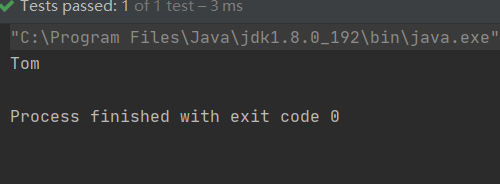
test3():
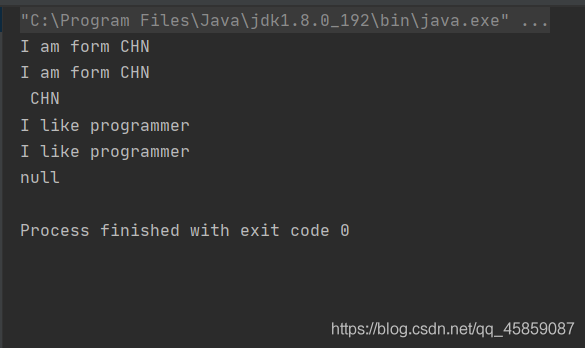
test4():

总结
本篇文章的上半部分就到这里了,希望对你有所帮助,也希望您能够多多关注自学编程网的更多内容!

- 本文固定链接: https://zxbcw.cn/post/216667/
- 转载请注明:必须在正文中标注并保留原文链接
- QQ群: PHP高手阵营官方总群(344148542)
- QQ群: Yii2.0开发(304864863)
